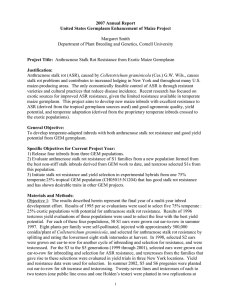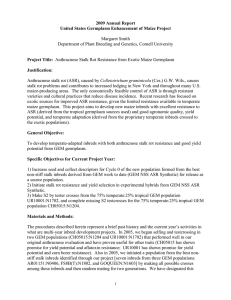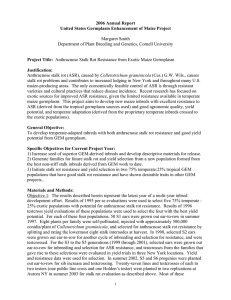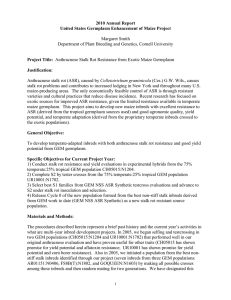2008 Annual Report United States Germplasm Enhancement of Maize Project Project Title: Justification:
advertisement
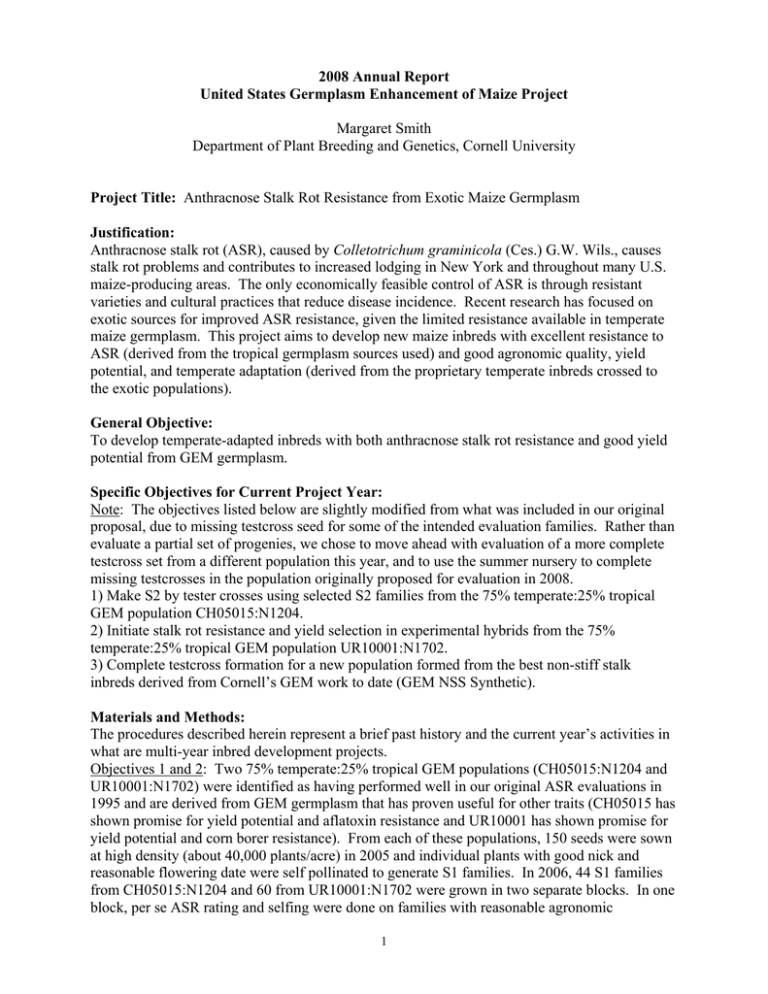
2008 Annual Report United States Germplasm Enhancement of Maize Project Margaret Smith Department of Plant Breeding and Genetics, Cornell University Project Title: Anthracnose Stalk Rot Resistance from Exotic Maize Germplasm Justification: Anthracnose stalk rot (ASR), caused by Colletotrichum graminicola (Ces.) G.W. Wils., causes stalk rot problems and contributes to increased lodging in New York and throughout many U.S. maize-producing areas. The only economically feasible control of ASR is through resistant varieties and cultural practices that reduce disease incidence. Recent research has focused on exotic sources for improved ASR resistance, given the limited resistance available in temperate maize germplasm. This project aims to develop new maize inbreds with excellent resistance to ASR (derived from the tropical germplasm sources used) and good agronomic quality, yield potential, and temperate adaptation (derived from the proprietary temperate inbreds crossed to the exotic populations). General Objective: To develop temperate-adapted inbreds with both anthracnose stalk rot resistance and good yield potential from GEM germplasm. Specific Objectives for Current Project Year: Note: The objectives listed below are slightly modified from what was included in our original proposal, due to missing testcross seed for some of the intended evaluation families. Rather than evaluate a partial set of progenies, we chose to move ahead with evaluation of a more complete testcross set from a different population this year, and to use the summer nursery to complete missing testcrosses in the population originally proposed for evaluation in 2008. 1) Make S2 by tester crosses using selected S2 families from the 75% temperate:25% tropical GEM population CH05015:N1204. 2) Initiate stalk rot resistance and yield selection in experimental hybrids from the 75% temperate:25% tropical GEM population UR10001:N1702. 3) Complete testcross formation for a new population formed from the best non-stiff stalk inbreds derived from Cornell’s GEM work to date (GEM NSS Synthetic). Materials and Methods: The procedures described herein represent a brief past history and the current year’s activities in what are multi-year inbred development projects. Objectives 1 and 2: Two 75% temperate:25% tropical GEM populations (CH05015:N1204 and UR10001:N1702) were identified as having performed well in our original ASR evaluations in 1995 and are derived from GEM germplasm that has proven useful for other traits (CH05015 has shown promise for yield potential and aflatoxin resistance and UR10001 has shown promise for yield potential and corn borer resistance). From each of these populations, 150 seeds were sown at high density (about 40,000 plants/acre) in 2005 and individual plants with good nick and reasonable flowering date were self pollinated to generate S1 families. In 2006, 44 S1 families from CH05015:N1204 and 60 from UR10001:N1702 were grown in two separate blocks. In one block, per se ASR rating and selfing were done on families with reasonable agronomic 1 performance. In the second block, testcrosses were made to an ASR-susceptible tester (B37) for ASR evaluations and to an elite tester (LH198) for yield trials. Progenies of S1 by tester crosses from CH05015:N1204 were evaluated in two replications for ASR resistance in Aurora NY (B37 tester) and in three replications at two NY locations for yield potential (LH198 tester) in summer 2007. A rank sum index was used to select the top performing families for both ASR resistance and yield. All the S2 ears from selected families were planted out ear-to-row in summer 2008 and were crossed to B37 for ASR evaluation and to LH198 for yield testing in 2009. Progenies of S1 by tester crosses from UR10001:N1702 were evaluated in summer 2008 in the same manner as described above for CH05015:N1204 S1 testcrosses. Objective 3: Population development for the GEM NSS Synthetic was initiated from the best new non-stiff stalk inbreds developed in our previous GEM breeding effort by making all possible F1 crosses among seven GEM-derived inbreds from three different GEM populations (five from FS8B(T):N1802 and two each from AR01150:N0406 and GOQUEEN:N1603). The resulting F1s were random mated in winter 2005-2006 and again in summer 2006. Selfing was done in winter 2006-2007 to generate 115 S1 families for initial stalk rot screening and testcrossing. These S1s were evaluated for anthracnose stalk rot resistance in single row, unreplicated plots in 2007, and simultaneously testcrossed to B37 (for stalk rot evaluation) and LH198 (for yield evaluation). Based on per se stalk rot evaluations, 28 S1 families were selected. Testcrosses involving these families that were missed in summer 2007 are being made in the 2008 breeding nursery, so a complete set of 28 S1s crossed to B37 for anthracnose stalk rot evaluation and to LH198 for yield evaluation will be ready for field trials in 2009. Progress to Date: Objective 1: We initiated inbreeding and selection for ASR resistance and yield potential in CH05015:N1204 in summer 2007. S1 families from this population were self-pollinated and inoculated in 2006 to select ASR-resistant families and to select the most resistant plants within these families. From the 44 S1s evaluated, 26 were selected as having good ASR resistance. Testcrosses to B37 from 23 of these S1s had sufficient seed for ASR evaluation in summer 2007 (two replications at Aurora NY). Testcrosses to LH198 from 25 of the 26 S1s had sufficient seed for yield evaluations in summer 2007 (two NY locations with three replications per location). ASR resistance ratings and yield data are presented in Table 1, along with data for three commercial check hybrids. ASR resistance of the experimental testcrosses was only better than that of the commercial checks in a couple cases. However, the B37 tester used to make these testcrosses was chosen for its extreme susceptibility (to facilitate identification of dominant or strongly additive resistance loci). These same experimental lines would likely produce more resistant testcrosses in combination with an inbred that is less susceptible than B37. Eight families were selected based on their rank sum for yield and ASR resistance, and one additional family (for which seed supply was inadequate to test for yield) was kept based on its ASR resistance alone. Selected families are shaded gray in Table 1. The S2 ears with the best ASR resistance from these nine families were planted out ear-to-row in summer 2008 (total of 31 S2 families) and were crossed to B37 for ASR evaluation and to LH198 for yield testing in the future. 2 Table 1. Results from evaluation of S1 families from CH05015:N1204 in summer 2007 for ASR resistance (B37 testcrosses, two reps, Aurora NY) and yield (LH198 testcrosses, three reps, two NY locations), and rank sum data. Selected families are shaded in gray. 7573 ASR Grain Stalk Entry Rating Yield Moisture Y/M Lodge Number (%) (bu/A) (%) Ratio (%) 26 -* 147 25.2 6.2 22 22 18.1 166 25.2 7.1 5 19 24.3 153 25.4 6.7 17 11 9.3 147 25.4 6.3 19 8 34.7 147 25.5 6.3 24 10 41.9 147 25.6 6.2 23 20 30.0 121 25.7 5.1 17 15 18.3 146 25.8 6.3 19 24 32.5 161 25.8 6.8 15 29 144 25.9 6.3 23 5 25.1 136 26.0 5.6 25 13 30.1 143 26.0 6.1 15 9 31.3 150 26.1 6.3 18 18 23.0 123 26.1 5.2 15 16 37.4 149 26.2 6.2 15 7 8.9 141 26.5 5.7 17 12 23.6 153 26.5 6.2 22 25 38.9 141 26.5 5.8 8 21 31.7 148 26.6 6.0 13 17 24.4 158 26.7 6.4 19 14 27.4 162 26.9 6.6 18 27 38.0 142 26.9 5.6 13 28 31.9 153 26.9 6.2 15 6 133 27.4 5.3 21 23 20.7 34B23 13.5 144 22.5 6.6 22 H8906 16.0 173 22.9 7.8 14 FS6102 13.3 157 24.2 6.7 21 * Insufficient testcross seed available for this evaluation. Root Lodge (%) 0 0 0 0 0 0 0 0 0 0 0 3 2 0 3 0 0 0 1 0 2 0 4 1 0 1 0 ASR Rating Rank 6 11 2 21 25 15 7 20 13 16 17 9 22 1 10 24 18 12 14 23 19 8 4 5 3 Y/M Ratio Rank 16 2 4.5 11 11 16 27 11 3 11 23.5 19 11 26 16 22 16 21 20 8 6.5 23.5 16 25 6.5 1 4.5 Rank Sum 8 15.5 13 32 41 42 18 23 36.5 35 28 35 38 23 26 45 38 20 20.5 46.5 35 10.5 6 7.5 Objective 2: We initiated inbreeding and selection for ASR resistance and yield potential in UR10001:N1702 in summer 2008. S1 families from this population were self-pollinated and inoculated in 2006 to select ASR-resistant families and to select the most resistant plants within these families. From the 60 UR10001:N1702 S1s, 29 were selected as having good ASR resistance. Testcrosses to B37 from 22 of these S1s had sufficient seed for ASR evaluation in summer 2008 (two replications at Aurora NY). Testcrosses to LH198 from 27 of the 29 S1s had sufficient seed for yield evaluations in summer 2008 (two NY locations with three replications per location). Stalk splitting and ASR ratings are being carried out at this time and one of the two yield trial locations has just been harvested (the second location should be harvested shortly). These data will be analyzed and summarized for the 2009 GEM update. 3 Objective 3: In 2005, all possible crosses were made among the lines chosen to contribute to the new non-stiff stalk GEM-related synthetic. The goal of this effort is to allow recombination among a diverse group of the most promising non-stiff stalk inbreds derived from our GEM work to date, and then be able to extract a new set of inbreds with excellent stalk rot resistance and improved yield potential and standability. The lines included in this new synthetic are FS8B(T):N1802-derived inbreds NY212 and NY215 and unreleased lines 222, 259, and 263 from this same population; AR01150:N0406-derived inbred NY266 and unreleased line 218; and GOQUEEN:N1603derived lines 233 and 239. Two generations of random mating were done in this material and then 115 S1 families generated in winter 2006-2007. These S1s were evaluated for ASR resistance in single row, unreplicated plots in Aurora 2007, and simultaneously testcrossed to B37 (for ASR evaluation) and LH198 (for yield evaluation). There were a relatively large number of testcrosses that lacked sufficient seed for evaluation. These testcross sets were completed in the summer 2008 nursery and will be evaluated in summer 2009. Summary of Accomplishments: Selection and inbreeding has been initiated in one new GEM-derived synthetic population and two new GEM populations to begin producing new ASR resistant inbreds from this project. A first generation of yield and stalk rot resistance evaluation in parallel sets of testcrosses was completed in 2007 on S1 families from CH05015:N1204, and a similar selection is underway in 2008 on S1 families from UR10001:N1702. The new GEM-derived synthetic, which underwent two cycles of random mating before inbreeding was initiated, will be similarly screened in 2009 pending adequate funding. 4
